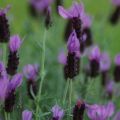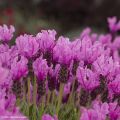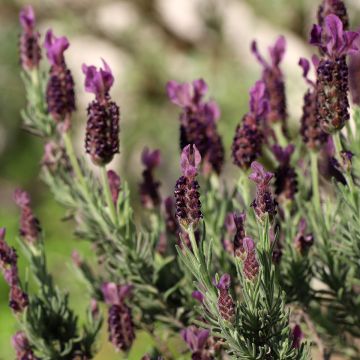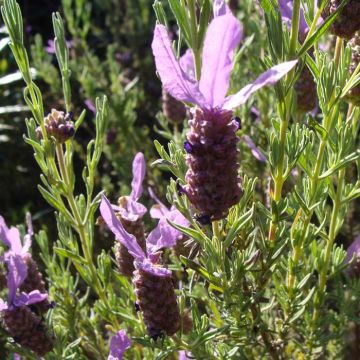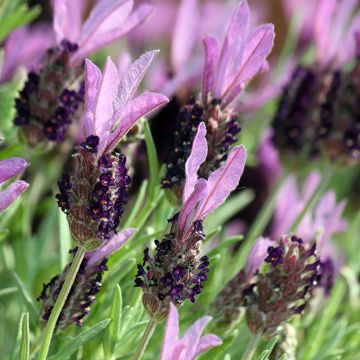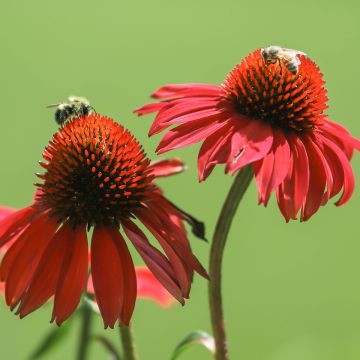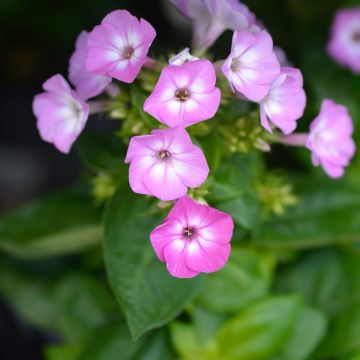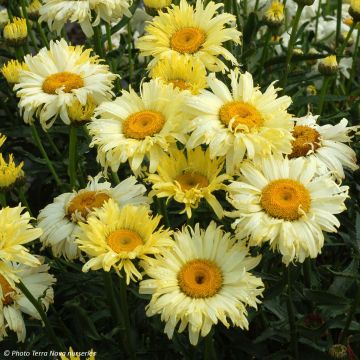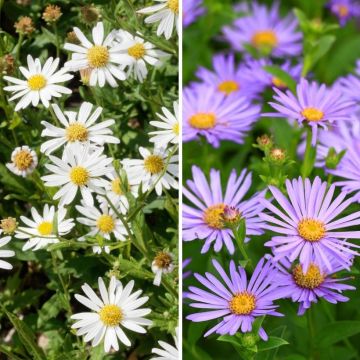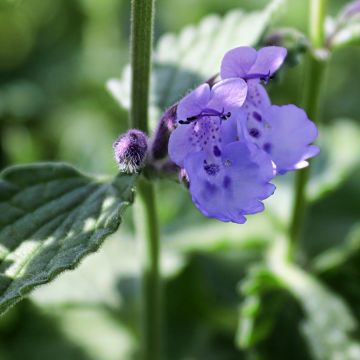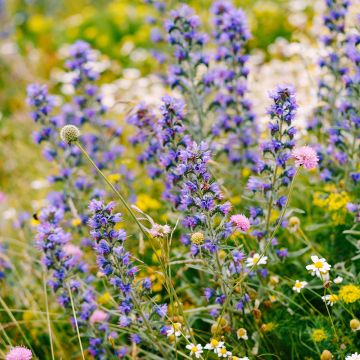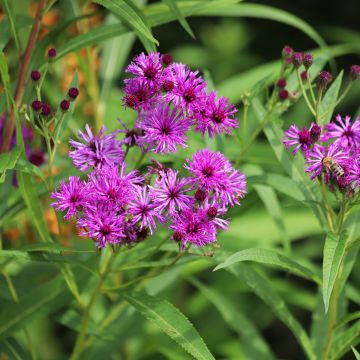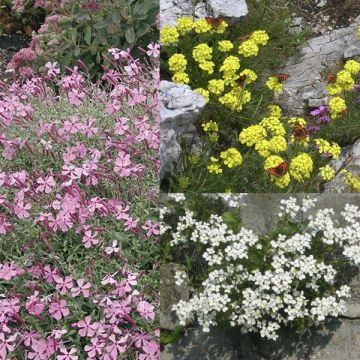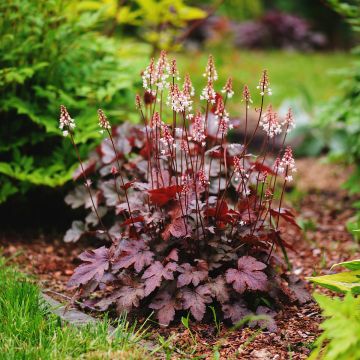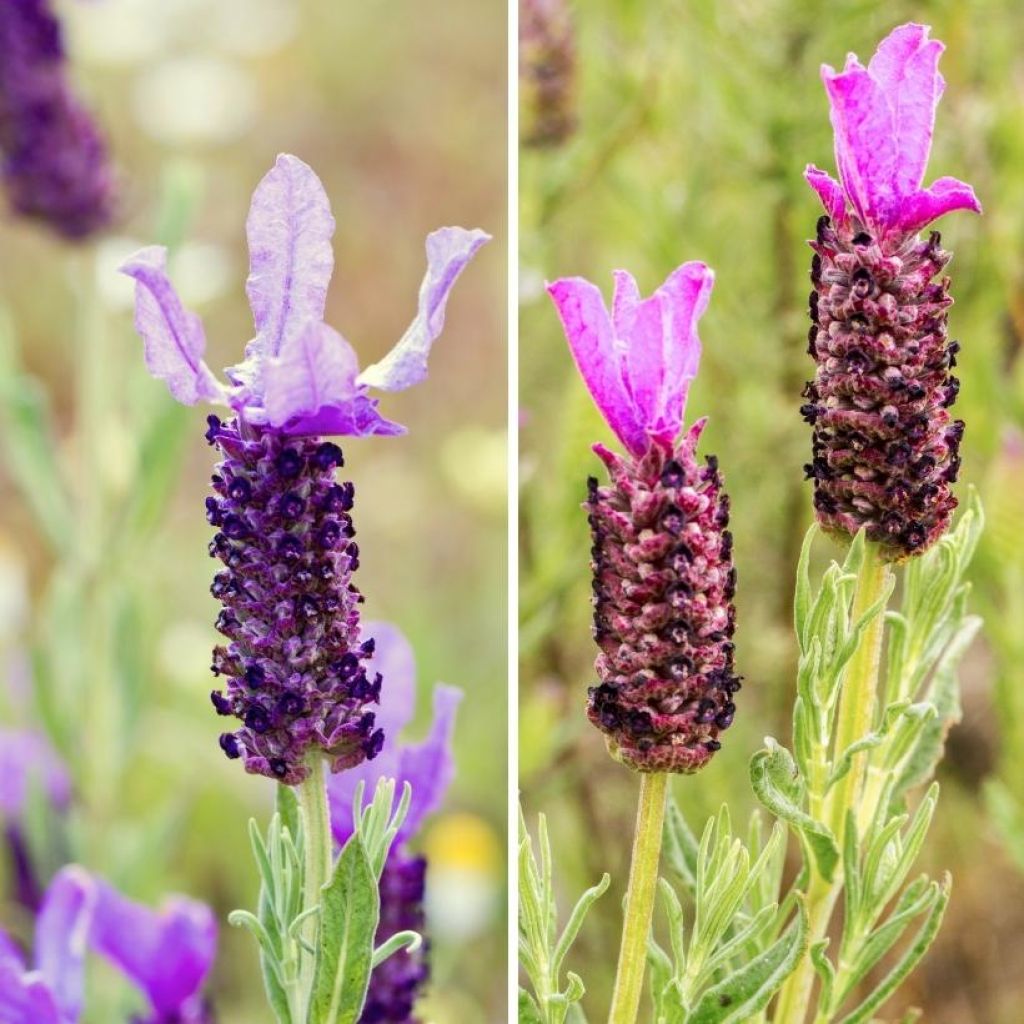

Lavandula stoechas and L. stoechas 'The Princess'
Lavandula stoechas and L. stoechas 'The Princess'
Lavandula stoechas Sp., The Princess
French Lavender, Spanish Lavender, Stoechas Lavender
This item cannot be shipped to the selected country
Delivery charge from €5.90
More information
Schedule delivery date,
and select date in basket
This plant carries a 12 months recovery warranty
More information
We guarantee the quality of our plants for a full growing cycle, and will replace at our expense any plant that fails to recover under normal climatic and planting conditions.
From €5.90 for pickup delivery and €6.90 for home delivery
Express home delivery from €8.90.
Does this plant fit my garden?
Set up your Plantfit profile →
Collection items (2 plants)
Description
The pair consists of:
- x 1 Butterfly lavender: the botanical species Lavandula stoechas, with large spike-like flowers topped with bracts of intense violet forming a tuft. It mainly flowers in spring and then again in late summer.
- x 1 Butterfly lavender 'The Princess' : tufted flowers of a remarkable intense pink. This variety blooms early, in April-May, and then again, in successive waves, throughout the summer.
The butterfly lavender is a plant native to the western Mediterranean basin. It is a shrub that naturally grows in full sun on siliceous slopes, poor in limestone. You will cultivate it in a mixture of soil and non-limestone fine gravel, ideally in a raised bed (20cm (8in) is enough). Also avoid watering it with "hard" tap water, especially if you grow it in a pot. From the mint family, this fragrant plant has a camphor-like aroma that pleasantly perfumes laundry and the garden. Respect a spacing of 40cm (16in) between each plant to create a dense lavender border, 50 to 60cm (20 to 24in) if you mix it with other small bushes.
The butterfly lavenders in this pair perfectly match cotton lavenders, prostrate rosemary 'Whitewater Silver', for example, and creeping brooms. It is also possible to mix several varieties of lavenders together, creating an elegant display, both in terms of the variety of flower and foliage colors, as well as the size and volume of the plants.
Butterfly lavender also makes beautiful potted plants. Choose a large pot (30 to 40cm (12 to 16in) in diameter). This will allow you to overwinter it frost-free in the coldest regions of our country.
Report an error about the product description
Flowering
Foliage
Plant habit
Botanical data
Lavandula
stoechas
Sp., The Princess
Lamiaceae
French Lavender, Spanish Lavender, Stoechas Lavender
Cultivar or hybrid
Other French Lavender
Planting and care
In nature, the butterfly lavender always lives in poor and siliceous, dry, arid, perfectly drained environments. It hates summer watering with hard water. Not very resistant to heavy frost (up to -7°C (19.4°F)), it is advisable to grow it in a raised bed, in front of a south or west-facing wall, in cooler regions, and in a pot for overwintering. It is also very well suited for pot cultivation.
In winter, it absolutely needs perfect drainage, and in summer, it needs to be kept dry (in the ground). The stoechas lavender will age better in poor soil, as its growth will be slower, and it will be less likely to thin out at the base. To limit this phenomenon, it should be pruned, from a young age, after flowering or in autumn, just above the first buds that can be seen on the wood. Lavenders and lavandins never 're-sprout' on old wood. The clump will thus branch out more and more, remaining compact, eventually forming beautiful dense cushions.
Planting period
Intended location
Care
This item has not been reviewed yet - be the first to leave a review about it.
Summer flowering perennials
Haven't found what you were looking for?
Hardiness is the lowest winter temperature a plant can endure without suffering serious damage or even dying. However, hardiness is affected by location (a sheltered area, such as a patio), protection (winter cover) and soil type (hardiness is improved by well-drained soil).

Photo Sharing Terms & Conditions
In order to encourage gardeners to interact and share their experiences, Promesse de fleurs offers various media enabling content to be uploaded onto its Site - in particular via the ‘Photo sharing’ module.
The User agrees to refrain from:
- Posting any content that is illegal, prejudicial, insulting, racist, inciteful to hatred, revisionist, contrary to public decency, that infringes on privacy or on the privacy rights of third parties, in particular the publicity rights of persons and goods, intellectual property rights, or the right to privacy.
- Submitting content on behalf of a third party;
- Impersonate the identity of a third party and/or publish any personal information about a third party;
In general, the User undertakes to refrain from any unethical behaviour.
All Content (in particular text, comments, files, images, photos, videos, creative works, etc.), which may be subject to property or intellectual property rights, image or other private rights, shall remain the property of the User, subject to the limited rights granted by the terms of the licence granted by Promesse de fleurs as stated below. Users are at liberty to publish or not to publish such Content on the Site, notably via the ‘Photo Sharing’ facility, and accept that this Content shall be made public and freely accessible, notably on the Internet.
Users further acknowledge, undertake to have ,and guarantee that they hold all necessary rights and permissions to publish such material on the Site, in particular with regard to the legislation in force pertaining to any privacy, property, intellectual property, image, or contractual rights, or rights of any other nature. By publishing such Content on the Site, Users acknowledge accepting full liability as publishers of the Content within the meaning of the law, and grant Promesse de fleurs, free of charge, an inclusive, worldwide licence for the said Content for the entire duration of its publication, including all reproduction, representation, up/downloading, displaying, performing, transmission, and storage rights.
Users also grant permission for their name to be linked to the Content and accept that this link may not always be made available.
By engaging in posting material, Users consent to their Content becoming automatically accessible on the Internet, in particular on other sites and/or blogs and/or web pages of the Promesse de fleurs site, including in particular social pages and the Promesse de fleurs catalogue.
Users may secure the removal of entrusted content free of charge by issuing a simple request via our contact form.
The flowering period indicated on our website applies to countries and regions located in USDA zone 8 (France, the United Kingdom, Ireland, the Netherlands, etc.)
It will vary according to where you live:
- In zones 9 to 10 (Italy, Spain, Greece, etc.), flowering will occur about 2 to 4 weeks earlier.
- In zones 6 to 7 (Germany, Poland, Slovenia, and lower mountainous regions), flowering will be delayed by 2 to 3 weeks.
- In zone 5 (Central Europe, Scandinavia), blooming will be delayed by 3 to 5 weeks.
In temperate climates, pruning of spring-flowering shrubs (forsythia, spireas, etc.) should be done just after flowering.
Pruning of summer-flowering shrubs (Indian Lilac, Perovskia, etc.) can be done in winter or spring.
In cold regions as well as with frost-sensitive plants, avoid pruning too early when severe frosts may still occur.
The planting period indicated on our website applies to countries and regions located in USDA zone 8 (France, United Kingdom, Ireland, Netherlands).
It will vary according to where you live:
- In Mediterranean zones (Marseille, Madrid, Milan, etc.), autumn and winter are the best planting periods.
- In continental zones (Strasbourg, Munich, Vienna, etc.), delay planting by 2 to 3 weeks in spring and bring it forward by 2 to 4 weeks in autumn.
- In mountainous regions (the Alps, Pyrenees, Carpathians, etc.), it is best to plant in late spring (May-June) or late summer (August-September).
The harvesting period indicated on our website applies to countries and regions in USDA zone 8 (France, England, Ireland, the Netherlands).
In colder areas (Scandinavia, Poland, Austria...) fruit and vegetable harvests are likely to be delayed by 3-4 weeks.
In warmer areas (Italy, Spain, Greece, etc.), harvesting will probably take place earlier, depending on weather conditions.
The sowing periods indicated on our website apply to countries and regions within USDA Zone 8 (France, UK, Ireland, Netherlands).
In colder areas (Scandinavia, Poland, Austria...), delay any outdoor sowing by 3-4 weeks, or sow under glass.
In warmer climes (Italy, Spain, Greece, etc.), bring outdoor sowing forward by a few weeks.

































